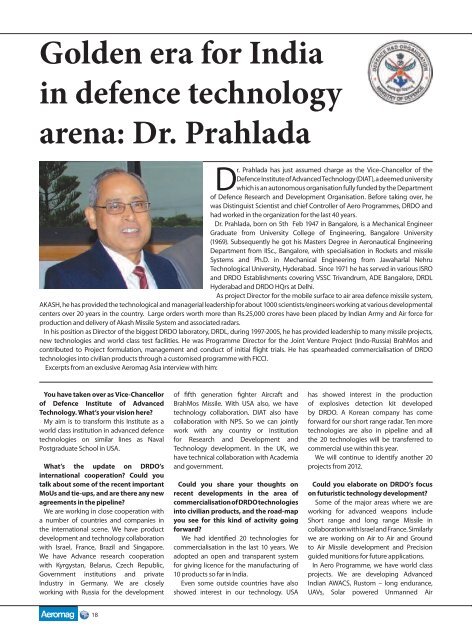July-August 2011 - Aeromag
July-August 2011 - Aeromag
July-August 2011 - Aeromag
Create successful ePaper yourself
Turn your PDF publications into a flip-book with our unique Google optimized e-Paper software.
Golden era for India<br />
in defence technology<br />
private Industry. We are ready to guide them<br />
for improving the quality. We will support all<br />
our industry partners and we will take it as a<br />
responsibility of DRDO. We have instituted a<br />
tight quality management system from the<br />
production of prototype itself with industry<br />
help.<br />
arena: Dr. Prahlada<br />
Dr. Prahlada has just assumed charge as the Vice-Chancellor of the<br />
Defence Institute of Advanced Technology (DIAT), a deemed university<br />
which is an autonomous organisation fully funded by the Department<br />
of Defence Research and Development Organisation. Before taking over, he<br />
was Distinguist Scientist and chief Controller of Aero Programmes, DRDO and<br />
had worked in the organization for the last 40 years.<br />
Dr. Prahlada, born on 5th Feb 1947 in Bangalore, is a Mechanical Engineer<br />
Graduate from University College of Engineering, Bangalore University<br />
(1969). Subsequently he got his Masters Degree in Aeronautical Engineering<br />
Department from IISc., Bangalore, with specialisation in Rockets and missile<br />
Systems and Ph.D. in Mechanical Engineering from Jawaharlal Nehru<br />
Technological University, Hyderabad. Since 1971 he has served in various ISRO<br />
and DRDO Establishments covering VSSC Trivandrum, ADE Bangalore, DRDL<br />
Hyderabad and DRDO HQrs at Delhi.<br />
As project Director for the mobile surface to air area defence missile system,<br />
AKASH, he has provided the technological and managerial leadership for about 1000 scientists/engineers working at various developmental<br />
centers over 20 years in the country. Large orders worth more than Rs.25,000 crores have been placed by Indian Army and Air force for<br />
production and delivery of Akash Missile System and associated radars.<br />
In his position as Director of the biggest DRDO laboratory, DRDL, during 1997-2005, he has provided leadership to many missile projects,<br />
new technologies and world class test facilities. He was Programme Director for the Joint Venture Project (Indo-Russia) BrahMos and<br />
contributed to Project formulation, management and conduct of initial flight trials. He has spearheaded commercialisation of DRDO<br />
technologies into civilian products through a customised programme with FICCI.<br />
Excerpts from an exclusive <strong>Aeromag</strong> Asia interview with him:<br />
You have taken over as Vice-Chancellor<br />
of Defence Institute of Advanced<br />
Technology. What’s your vision here?<br />
My aim is to transform this Institute as a<br />
world class institution in advanced defence<br />
technologies on similar lines as Naval<br />
Postgraduate School in USA.<br />
What’s the update on DRDO’s<br />
international cooperation? Could you<br />
talk about some of the recent important<br />
MoUs and tie-ups, and are there any new<br />
agreements in the pipeline?<br />
We are working in close cooperation with<br />
a number of countries and companies in<br />
the international scene. We have product<br />
development and technology collaboration<br />
with Israel, France, Brazil and Singapore.<br />
We have Advance research cooperation<br />
with Kyrgystan, Belarus, Czech Republic,<br />
Government institutions and private<br />
Industry in Germany. We are closely<br />
working with Russia for the development<br />
of fifth generation fighter Aircraft and<br />
BrahMos Missile. With USA also, we have<br />
technology collaboration. DIAT also have<br />
collaboration with NPS. So we can jointly<br />
work with any country or institution<br />
for Research and Development and<br />
Technology development. In the UK, we<br />
have technical collaboration with Academia<br />
and government.<br />
Could you share your thoughts on<br />
recent developments in the area of<br />
commercialisation of DRDO technologies<br />
into civilian products, and the road-map<br />
you see for this kind of activity going<br />
forward?<br />
We had identified 20 technologies for<br />
commercialisation in the last 10 years. We<br />
adopted an open and transparent system<br />
for giving licence for the manufacturing of<br />
10 products so far in India.<br />
Even some outside countries have also<br />
showed interest in our technology. USA<br />
has showed interest in the production<br />
of explosives detection kit developed<br />
by DRDO. A Korean company has come<br />
forward for our short range radar. Ten more<br />
technologies are also in pipeline and all<br />
the 20 technologies will be transferred to<br />
commercial use within this year.<br />
We will continue to identify another 20<br />
projects from 2012.<br />
Could you elaborate on DRDO’s focus<br />
on futuristic technology development?<br />
Some of the major areas where we are<br />
working for advanced weapons include<br />
Short range and long range Missile in<br />
collaboration with Israel and France. Similarly<br />
we are working on Air to Air and Ground<br />
to Air Missile development and Precision<br />
guided munitions for future applications.<br />
In Aero Programme, we have world class<br />
projects. We are developing Advanced<br />
Indian AWACS, Rustom – long endurance,<br />
UAVs, Solar powered Unmanned Air<br />
vehicles, Fifth Generation modern combat<br />
aircraft development in collaboration with<br />
Russia, the LCA project and Electronic<br />
Warfare Systems to all Combat aircraft<br />
with Indian Air Force including LCA, MiG29,<br />
Sukhoi, Jaguar and Mirage.<br />
We are developing Aerostat of two<br />
different size and capabilities. As a long<br />
term project we will have an Airship<br />
programme. Even though some of<br />
our projects are delayed, the end users<br />
including Army, Air Force and Navy have<br />
accepted all DRDO developed products<br />
and placed orders. This has confirmed<br />
users commitment to indigenously<br />
developed products once they meet their<br />
expectations.<br />
What details can you share with us<br />
on ‘Defence Technology Vision 2050’<br />
roadmap being framed?<br />
For the next 20 years we will follow the<br />
LTIPP – Long Term Integrated Prospective<br />
Planning document of Defence Ministry<br />
for development of new products and<br />
technologies. New initiatives cover cyber<br />
security, low intensity conflicts and satellite<br />
based systems.<br />
We are working on combat aircraft,<br />
maritime Surveillance radar, Weapon<br />
locating Radars and Central Acquisition<br />
radars. Next technology communication<br />
and EW systems are on the anvil.<br />
Could you throw more light on the 1500<br />
horsepower engine and artillery guns of<br />
155 mm calibre that you are working on?<br />
Our own, we have taken a decision that<br />
with either foreign collaboration or with<br />
support from public and private sector, we<br />
will develop the tank engine of 1000hp and<br />
1500hp. We have also decided to make our<br />
own gas turbine engine for aircraft, marine<br />
gas turbine engine for Ship though these<br />
are highly complex technology challenges.<br />
Considering difficulties experienced by<br />
Indian Army in requiring artillery guns,<br />
DRDO has been requested by the army to<br />
taken up indigenous develop of 155 calibre<br />
guns.<br />
How is DRDO able to meet the high<br />
standards of quality and technology for<br />
its end-users?<br />
The quality of defence product during<br />
production comes from industry. The<br />
production part will be done by DPSUs, and<br />
What are the other new initiatives of<br />
DRDO?<br />
DRDO has already started supporting the<br />
innovations in a big way not only in science<br />
and technology but also administration and<br />
management.<br />
There should be synergy between Industry<br />
and academia. User, DRDO, Industry and<br />
Academia should work and should expand<br />
laterally for understanding each other.<br />
Horizontal integration, of these 4 entities<br />
while their deep specialization have to<br />
coexist.<br />
Unless it happens, we cannot have a<br />
synergy. For increasing the productivity<br />
and efficiency, DRDO should collaborate<br />
with academia for research and also user in<br />
operation. Industry should be a part from<br />
the development of prototype.<br />
There is no major defence programme<br />
going on in Europe or USA because of their<br />
current financial cries. Russian defence<br />
programme for the development of fifth<br />
generation fighter is also being done with<br />
India’s support.<br />
Thus, there is lot of potential in Europe and<br />
India should tap and utilise this opportunity.<br />
This is considered to be a golden era for<br />
India. Since there are no major defence<br />
programmes in developed countries will be<br />
ready to collaborate with India.<br />
We should exploit and utilise this golden<br />
opportunity to improve our capability<br />
and capacity in developing high tech<br />
engineering products.<br />
A e r o m a g 18<br />
A e r o m a g 19




